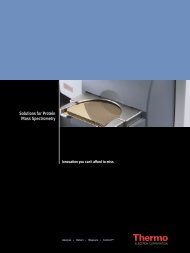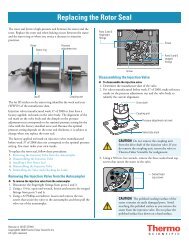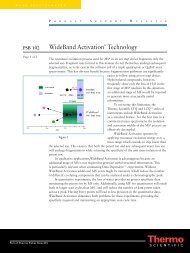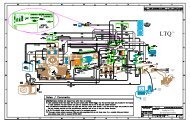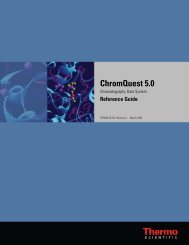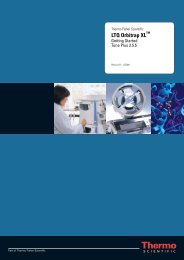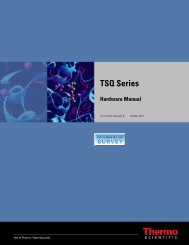TSQ Series
TSQ Series
TSQ Series
Create successful ePaper yourself
Turn your PDF publications into a flip-book with our unique Google optimized e-Paper software.
A Étalonnage en masse élevée<br />
Polarité ions<br />
positifs<br />
Polarité ions<br />
négatifs<br />
Pour effectuer un étalonnage en masse élevée en polarité ions positifs<br />
1. Définissez le spectromètre de masse sur la polarité ions positifs. (Vérifiez que le bouton Polarity se<br />
trouve en polarité ions négatifs.)<br />
2. Perfusez le calibrant Ultramark 1621 à un débit de 1 à 3 μl/min.<br />
a. Chargez une seringue propre de solution d’étalonnage Ultramark 1621 et insérez la seringue<br />
dans la pompe seringue. Pour préparer la solution d’étalonnage Ultramark 1621, se reporter à<br />
la section « Solution d’étalonnage en masse élevée Ultramark 1621 » à la page 112.<br />
b. Choisissez Setup > Syringe Pump & Sample Loop pour afficher la vue Syringe Pump and<br />
Sample Loop dans la partie supérieure droite de l’espace de travail.<br />
c. Entrez ou sélectionnez les réglages pertinents, puis cliquez sur Apply pour lancer la perfusion.<br />
En mode Full Scan, le spectre doit ressembler à celui illustré à la Figure 74.<br />
Figure 74. Spectre d’ions positifs Ultramark 1621<br />
Le Tableau 6 répertorie les ions positifs Ultramark 1621.<br />
Tableau 6. Rapports masse/charge des ions positifs Ultramark 1621 (Feuille 1 de 2)<br />
Ions positifs Ultramark (m/z)<br />
822,0162<br />
922,0098<br />
1022,0034<br />
1121,9970<br />
1221,9906<br />
1321,9843<br />
1421,9779<br />
1521,9715<br />
1621,9651<br />
1721,9587<br />
1821,9523<br />
98 Guide de démarrage rapide de la gamme <strong>TSQ</strong> Thermo Scientific





